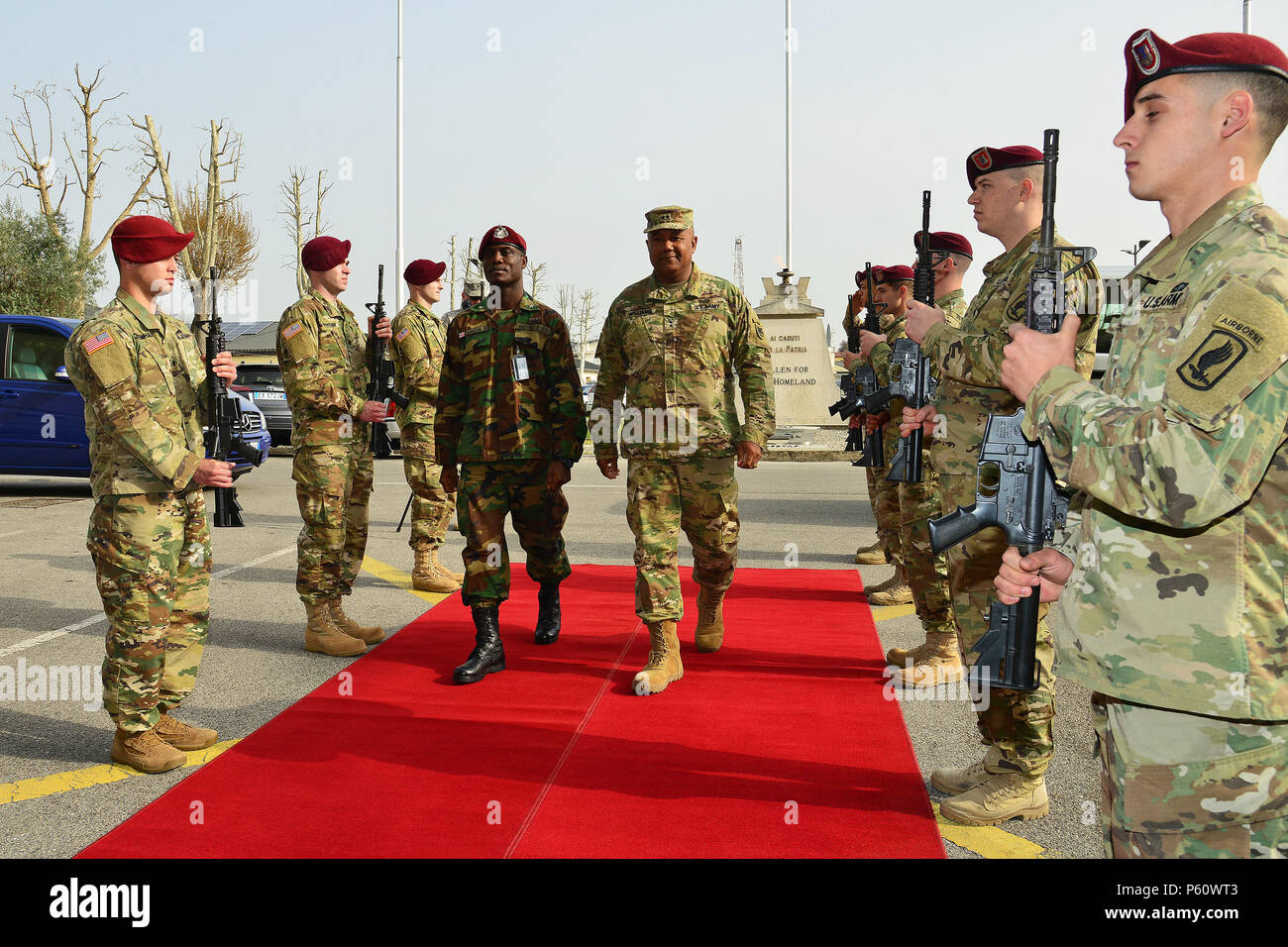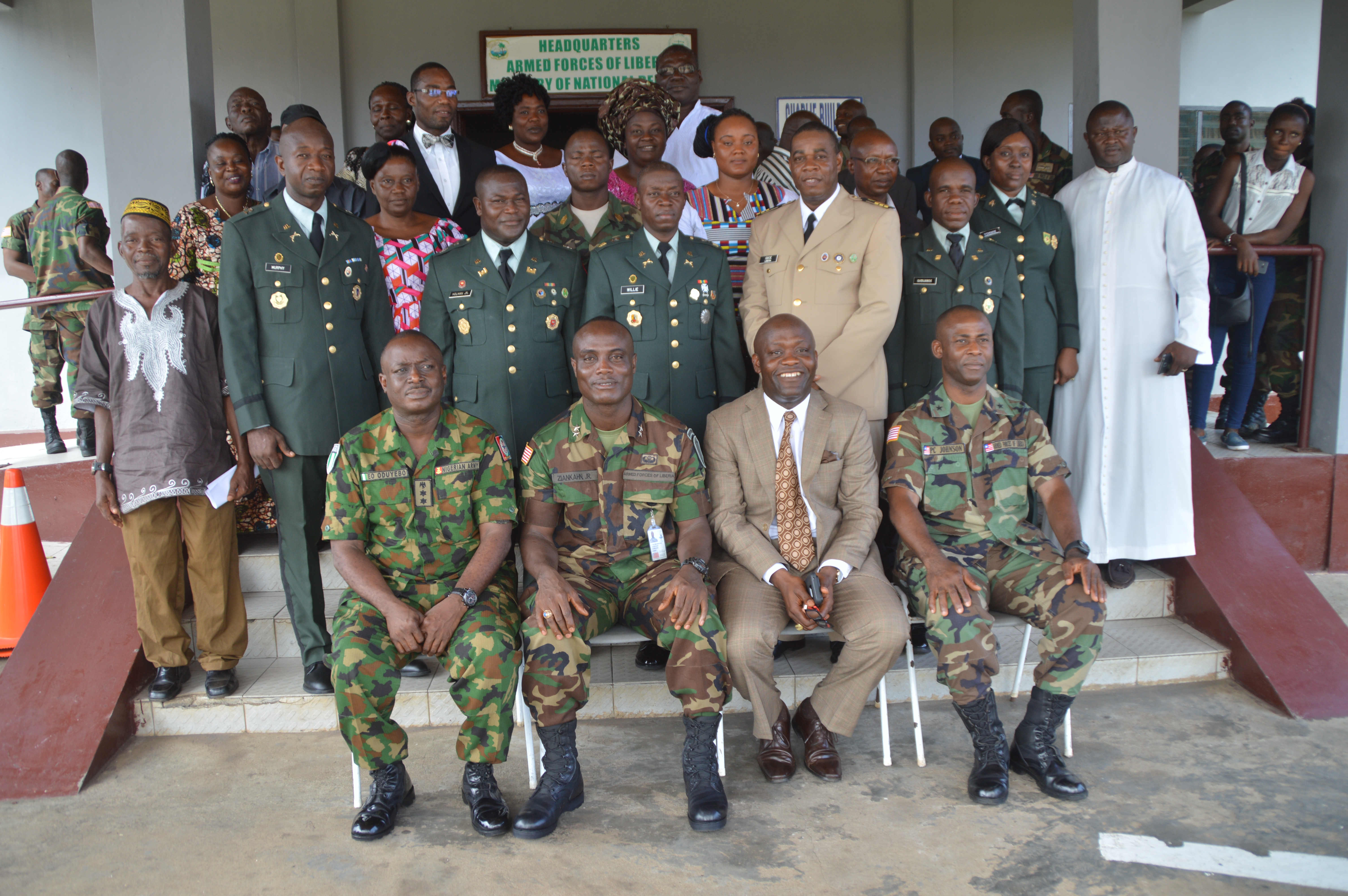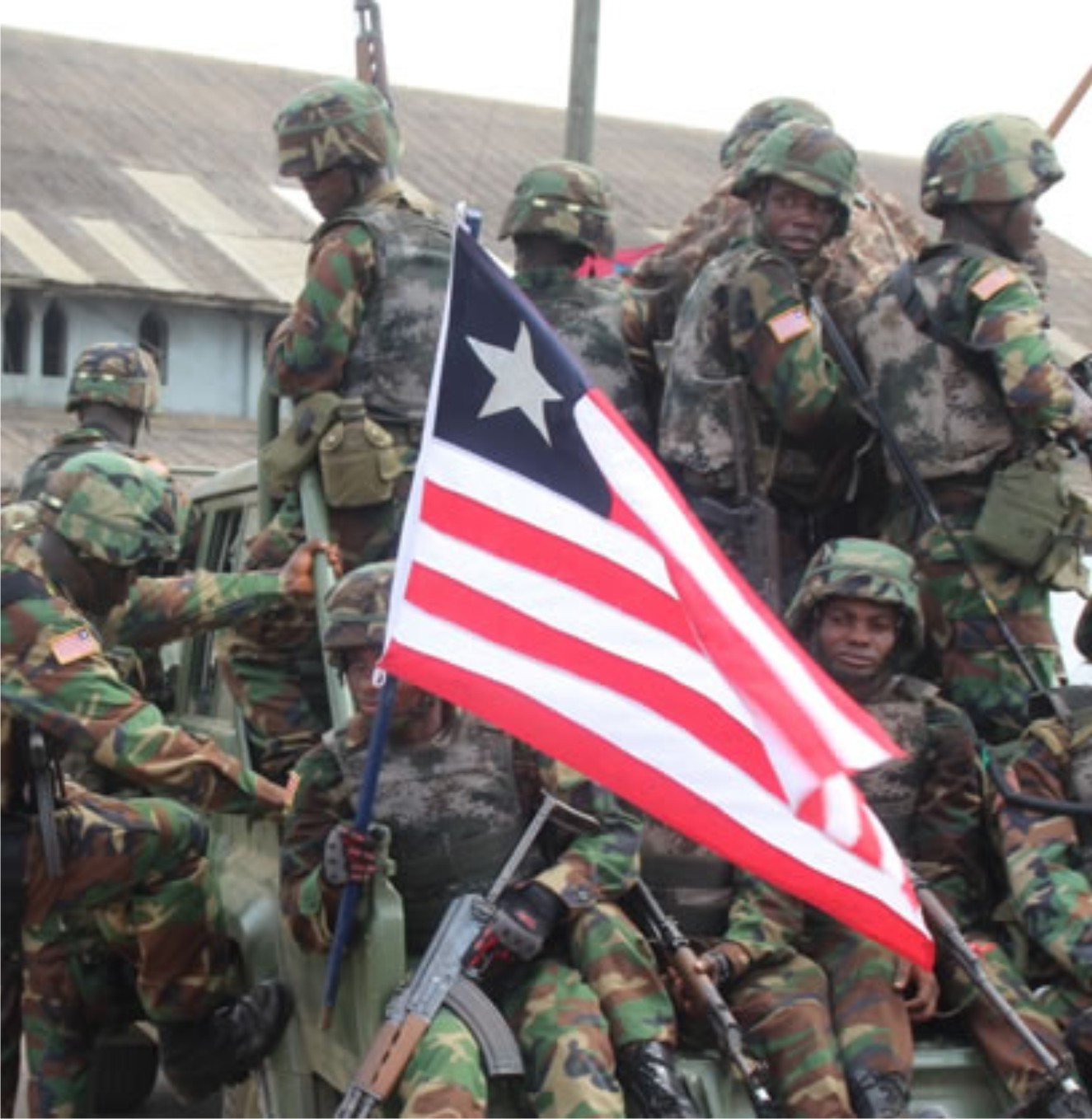Military Of Liberia - A platoon-sized infantry unit of the Armed Forces of Liberia (AFL) disembarked on June 20, 2013 to join the African International Support Mission (AFISMA) in Mali. They will be part of the Nigerian battalion, with First Lieutenant Nathaniel Waka as the platoon section commander.
This is the first time Liberia has participated in a peacekeeping operation in 52 years. In 1961, Liberia sent troops to the Congo, a UN peacekeeping force established under UN Resolution 143 of 14 July 1960, to deal with the crisis in the Congo.
Military Of Liberia
![Dvids - Images - Armed Forces Of Liberia Completes Annual Weapons Qualification [Image 2 Of 2]](https://cdn.dvidshub.net/media/thumbs/photos/1304/904719/1000w_q75.jpg) Source: cdn.dvidshub.net
Source: cdn.dvidshub.net
The Republic of Liberia is a small West African country with a young and ambitious armed force of 2,000 soldiers. At the end of the 14-year civil war in 2003, the Liberian army was deactivated and demobilized, and 100,000 combatants (including former AFL and rebel forces) disarmed.
Armed Forces Of Liberia [Afl] / Liberian Army
The Liberian army of about 2,000 men was formed from scratch in 2003 after the end of the Second Liberian Civil War. The UN peacekeeping operation that helped build Liberia's military was officially disbanded in 2018, leaving the nation vulnerable to threats.
During the two-year transition period, 103,018 combatants officially participated in the disarmament, demobilization and reintegration (DDR) process, 11 percent of whom were children. In November 2004, the process was declared complete, but in reality it was not completely completed.
First, there are serious numerical discrepancies: for example, more than 100,000 combatants are ``unarmed'' while only about 27,000 have collected weapons; another, 103,018 combatants were "disarmed" and demobilized, while only 13,872 were included in the reintegration program.
Second, I don't think even the 100,000 figure covers all fighters from the Liberian Civil War, as some young fighters did not report to the DDR, while others fell with their combat units before the 2003 conflict.
Ethnic Groups
marked by previous conflict experience. Liberia's population consists of several indigenous ethnic groups that migrated from Sudan in the late Middle Ages. Other groups include the ancestors of the Black Americo-Liberians who immigrated from the Americas between 1820 and 1865 and founded Liberia, as well as black immigrants from neighboring West African countries.
The stated mission of the Armed Forces of Liberia (AFL) has historically been to protect and defend the country's borders, protect national security, and protect the population from threats and aggression, but in the 1980s, the AFL's role increased due to the invasion.
 Source: d1ldvf68ux039x.cloudfront.net
Source: d1ldvf68ux039x.cloudfront.net
soldiers to the country. government In 1984, operational components of the AFL included the Liberian National Guard Brigade and related units, with a strength of about 6,300 and a full Liberian National Guard of about 450 personnel.
Liberia's history generally begins with the arrival of Portuguese traders in the mid-1400s and the rise of transatlantic trade. Coastal communities traded many goods with Europeans, but Malagueta was rich in peppercorns, so the area became known as the Agricultural Coast.
Armed Forces Of Liberia Afl
The Armed Forces of Liberia [AFL] is an evolving and evolving organization that was established in 2006. "Building a force for good" - the unofficial motto of the Armed Forces of Liberia, named by the President of Liberia, Ellen Johnson-Sirleaf.
This new military reform represents a reorientation in the way the force is being rebuilt, with an emphasis on human rights and professionalism. The UN Security Council adopted Resolution 2066 in September 2012, halving UN troops in Liberia to less than 4,000 by 2015, and calling on the Liberian security sector to fill the gap.
Liberia is one of only two countries in Africa, along with Ethiopia, that were never colonized by European powers during the 1880-1900 scramble for Africa. However, this is controversial because the country was founded by free black American immigrants.
From the 1820s until 1989, these Americo-Liberians ruled. Liberia was ruled by a military dictatorship until the 1990s, and then suffered two long civil wars. In 2003, Liberian women helped end the Second Civil War, and in 2005, Ellen Johnson-Sirleaf, the first African female head of state, was elected president of Liberia.
Early History
The current president, George Weah, was elected in 2017. Government fighters claim to be former fighters from the 1990-1997 Liberian civil war, including the National Patriotic Front of Liberia (NPFL) and the National Patriotic Front for the Independence of Liberia.
(INPFL), and the Liberian Peace Council (LPC). , United Liberation Movement for Democracy (ULIMO) and Lofa Defense Force (LDF). USAFRICOM supported the development of the Armed Forces of Liberia (AFL) in the Security Sector Reform (SSR) program managed by the US Department of State.
 Source: c8.alamy.com
Source: c8.alamy.com
The United States Department of Defense has supported and continues to support the SSR through activities aimed at reforming the Liberian Defense Sector. In January 2010, US FRICOM through the US Department of Defense, i.e. Naval Forces Africa, established Operation Freedom Forward (OOL).
The OOL consists of 45-52 US military personnel who travel with the AFL to strengthen the AFL's institutional, operational and human capacity. It is often said that Liberia was one of two independent African countries after the African Struggle, which is misleading because the indigenous Africans had little economic or political power in the new republic.
Civil Wars
A handful of Liberian women serve in the AFL. Most of the women work in administration, while others are mechanics or musicians. In 2009, only two Liberian women served as non-commissioned officers. Liberia's rank-and-file male soldiers are slowly adjusting to women in leadership positions.
Army men are not used to being led by women. The New Armed Forces of Liberia provides specialized training for Military Police, Materiel and Supply, Combat Medical Supply Specialist, Human Resource Specialist, Public Relations Specialist, Combat Engineering Specialist, Driver Training, Chaplain Training and Legal.
. Finance Specialist, Basic Instructor Course, Military Intelligence, Transport Specialist, Light and Heavy Mechanics, Radio and Telecommunications, Petroleum Supply, etc. On February 11, 2014, a Liberian was appointed as the head of the Liberian Army for the first time since the end of the civil war more than 10 years ago.
Liberian President Ellen Johnson Sirleaf has appointed Lt. Col. Daniel Di Ziancan as the new Chief of Staff of the Liberian Armed Forces. This is quite significant for Liberia because until now the head of the army is not a Liberian but actually a Nigerian.
War Veteran Association
In 1989, former American-Liberian officer Charles Taylor invaded Liberia with his National Patriotic Front. With the support of Libya, Burkina Faso and the Ivory Coast, Taylor soon took control of much of eastern Liberia. Dow was assassinated in 1990, and for the next five years, Liberia exported the country's wealth to foreign buyers and divided it among warlords numbering in the millions.
Although they were black, the Americo-Liberians created a cultural divide. From the day they arrived, they set out to create an American culture rather than an African one. They spoke English, dressed like Americans, built southern farmhouses, ate American food, practiced Christianity, and lived in monogamous relationships.
 Source: mod.gov.lr
Source: mod.gov.lr
They modeled the Liberian government after the United States. US military personnel providing training, support and advisory roles to the AFL is a key objective of Operation Freedom Forward. Under the supervision of the US military, Liberian soldiers managed day-to-day operations at the Edward Binyah Kesselli Rifle Camp in Momrovia in early 2011.
Bravo Company, 1st Battalion, 23rd Infantry Brigade, AFL, saw its first combat action. EBK Annual Rifle Qualification. Camp installations without US military personnel acting as range personnel. In 2008, Liberia's Ministry of National Defense set a goal of training 2,000 soldiers by 2010.
Armed Forces Of Liberia Afl - History
The AFL exceeded this target by nearly 200 troops in June 2009, bringing the total strength of the Armed Forces to 2,133 personnel. The activation of the armed forces is carried out under the directives and regulations of the National Defense Act of 2008 of Liberia.
All qualified personnel between the ages of 18 and 35 are eligible to serve in the Armed Forces of Liberia. Recruiters must not violate or violate human rights. The minimum term of service is five years.
The Auxiliary Battalion stationed at the BST consisted of the Medical Company, the LNG Brigade Band, the Special Brigade Unit (parade unit) and the Military Police. In 1984, most LNG battalions were commanded by colonels. The exceptions were the Second Sixth Infantry Battalion, commanded by lieutenant colonels, and the First Small Field Artillery Battalion, commanded by a captain.
However, the United States has long used Liberia as an important base of operations in Africa, and during the Cold War, the United States provided millions of dollars in aid to help prop up Doe's increasingly unpopular regime.
The embroidery and quilting skills of the black settlers of America are firmly embedded in Liberian art, while the music of the American South is mixed with ancient African rhythms, harmonies and dances. Christian music is popular and is sung a cappella in the traditional African style.
"Ex-combatants" or "veterans" are former fighters of the National Patriotic Front of Liberia (NPFL) who must be rehabilitated and reintegrated into mainstream civil society. Under Taylor, he ran his own bureau with a staff and budget and was paid more than the average civil servant.

Under Taylor's leadership, they became a new tool to silence dissenters and citizens critical of the government. Taylor seemed convinced that his heart's support and source of strength were the ragtag people who had brought him to power.
On April 12, 1980, Master Sgt. Samuel K. Doe and less than 20 soldiers overthrew Americo-Liberian President William Tolbert. The people of Liberia celebrated the coup as liberation from Americo-Liberian rule. However, Doe's dictatorial government was no better for the Liberian people than before.
After a failed coup attempt against him in 1985, Doe responded with brutality against suspected conspirators and their followers. From March 5 to 22, 2012, the Armed Forces of Liberia conducted a formal training for non-commissioned officers from March 5 to 22, 2012.
AFL, they were. US-based training teams have always taught. However, during this training, non-commissioned officers of the AFL were selected and, after undergoing a little refresher training, were ordered to assist their enlisted men as needed, along with US advisers.
The end result: Soldiers are better informed and more experienced among the Corps' NCOs. Activation ceremony for the first three companies; Alpha, Bravo and Charlie of the First Battalion of the 23rd Infantry Brigade of the reformed Armed Forces of Liberia on Wednesday December 19, 2007 at the Barclay Training Center (BTC) in Monrovia.
Several distinct ethnic groups have inhabited what is now Liberia for at least 1,000 years, but the major kingdoms of Dahomey, Asante, and the Benin Empire along the West African coast to the east did not arrive.
In 1996, Liberian warlords signed a peace accord and began turning their soldiers into political parties. However, the peace did not last. In 1999, another rebel group, the Liberians United for Reconciliation and Democracy (LURD), challenged Taylor's rule.
LURD supported Guinea, while Taylor continued to support rebel groups in Sierra Leone. As the 2013 Armed Forces of Liberia recruitment process ends in September 2013, the service has trained drill sergeants since 2010 for the first round of conscription.
 Source: c8.alamy.com
Source: c8.alamy.com
More than 770 Liberian civilians applied for military service; but less than 150 will be selected. A team of seven Armed Forces of Liberia or AFL drill sergeants will undergo the training. In the past, contractors trained soldiers in the Armed Forces of Liberia.
In recent years, seven AFL soldiers have graduated from the United States Military Academy at Fort Jackson, N.C., which is now equipped to train AFL recruits. ECOWAS, the Organization for Economic Co-operation and Development of West African States, is conducting a peacekeeping operation involving about 12,000 men from ten nations, including 9,000 men from Nigeria.
It was replaced by a United Nations force (UNMIL) with observers from 48 countries (including Sweden). Bangladesh, Ethiopia, Ghana, China, Mongolia, Namibia, Nigeria, Pakistan, Senegal. In 2005, elections were held in Liberia, and Ellen Johnson-Sirleaf, who was once arrested by Samuel Doe and defeated by Taylor in the 1997 election, was elected President of Liberia.
She was the first female head of state in Africa. Liberian culture is based on the heritage of the Americo-Liberian settlers of the southern United States and the country's 16 indigenous and migrant groups. Although indigenous languages are widely spoken, English remains the official language of Liberia.
85.5 percent of Liberia's population is Christian, while Muslims make up 12.2 percent of the population. On March 10, 2002, six armed AFL soldiers harassed and robbed civilians at an agricultural project in Clean Town, Bomi.
The soldiers also arrested the project's Agriculture Manager, John Nizan, and forced him to do 3 weeks of hard labor. Nizan fled when LURD protesters stormed the city. Later, the "Clean Town" became empty and its inhabitants became Internally Displaced Persons (IDPs).
Following the signing of the CPA, the Disarmament, Demobilization and Reintegration Program in 2005 disarmed more than 100,000 combatants, but the reintegration programs were partially successful. UNMIL is deployed throughout the territory to ensure security. The CPA formed the National Transitional Government of Liberia (NTGL) composed of representatives from former rebel groups, political parties, the former Taylor government, and civil society.
He was accused of massive corruption. The organization of the Hinterland and attempts to establish effective control there through indirect administration were a direct response to British and French intervention in the region. Another result of Liberia's territorial disputes with the two colonial powers was the formation of the Liberian Frontier Force (LFF) in 1908.
The task of the 500-man force was to patrol the Overseas Borders, but more importantly, to organize the border defense. prevent the type of disorder that invites intervention. The LFF was placed under the command of a British officer who had recruited most of its troops in Sierra Leone.
Originally, the French considered the LFF to be a "British army of occupation", but their requests to assign French officers and colonial soldiers to it were ignored. The Armed Forces of Liberia (AFL) was created from the Liberian Frontier Force (LFF).
The Liberian Border Guard was a tax collector and enforcer of government payments. The idea of raising taxes was to keep Americans out of the dirty jobs of forced labor. Therefore, the composition of the Liberian border troops consisted mainly of tribes, first of all the northern tribes.
There was a language barrier before. Little by little, the Kranians joined the Border Guards.
liberia military size, armed forces of liberia, liberian army, liberia military bases, liberian military equipment, liberian military ranks, liberia army equipment, summary of liberian civil war